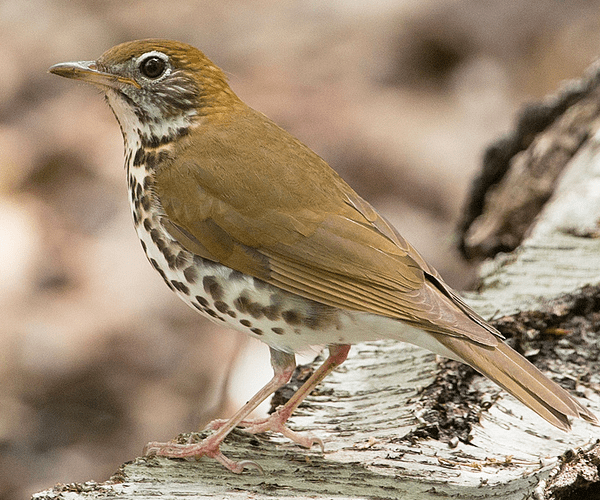ID Workshop: Use 4 Basic Keys Plus Migration Timing to Sort Out Your Thrushes
April 23, 2014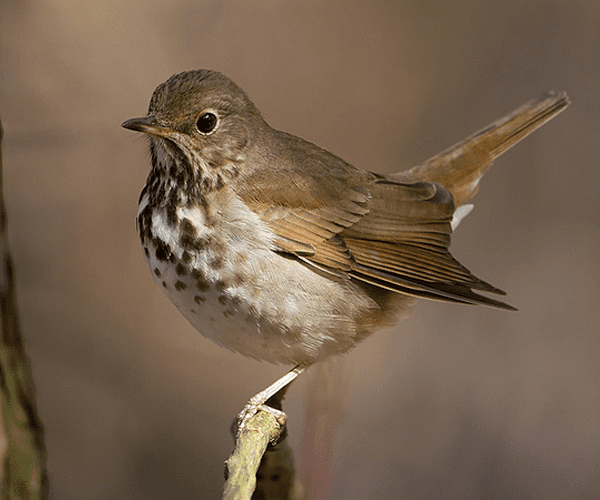
In spring and fall, all sorts of birds come flooding through North America on their way to breeding or wintering grounds. This is the time to see species that don’t normally live around you—and some of them may leave you scratching your head. Take this bird, for instance: lots of brown songbirds perch on branches, but which one is it? Let’s tick through the steps: First, use four key visual clues to get an idea of the group it belongs to; then tap into your knowledge of migration timing for some crucial clues; and then check out plumage details to narrow down an ID.
1. What do we see? The first step is to quickly review the four keys to bird identification:
- Shape: rounded head, plump body, longish legs, and fairly short tail
- Color pattern: dark spots on the breast, brown upperparts
- Behavior: perched on a branch, tail cocked
- Habitat: though you can’t tell for sure in this picture, let’s say you saw this bird in a Massachusetts forest in April
2. Which group does this bird belong in? When we’re looking at a perching brown songbird, we start with sparrows, thrushes, and finches. The breast pattern is spotted, not streaked, and the bill is thin, which allow us to cut out sparrows and finches (which have stout, short bills and don’t usually have round spots on the breast). The shape is similar to an American Robin. Now we can confidently hone in on thrushes.
Looking closely at the photo above, we see these spots become smudgy on the sides and belly. This eliminates Wood Thrush (right) which is larger and has well-defined spots all the way down the belly. We’re left with five species in the genus Catharus: Hermit, Swainson’s, Veery, plus the less commonly seen Gray-cheeked and Bicknell’s. These thrushes can be tricky—but we can get some help from migration timing before we dive into plumage details.
3. When are the birds near you? Timing, especially in winter and spring, can be immensely helpful in identifying Catharus thrushes. From November to March it’s easy—Hermit Thrush is the only one of the five species present in the U.S. and Canada. Swainson’s, Veery, and Gray-cheeked thrushes are in South America for the winter (Bicknell’s is in the Caribbean). Come spring, Hermit Thrush is the earliest migrant of this group. Check out this map (data drawn from eBird) of the three most widespread species. Redder colors indicate a higher percentage of the given species on eBird checklists. See how the map starts off with only Hermit Thrushes in the U.S.? Also note the different timing and paths of Swainson’s and Veery. (If you’re curious about Wood Thrush, check out this animated map from eBird.)

Bottom line: migration timing, given our sighting info of Massachusetts in April, helps us cross Swainson’s Thrush off the list of possibilities.
4. Plumage details Many times, the combination of the four keys to visual ID, plus knowledge of migration timing, will allow you to identify a bird with certainty. But during peak migration, the Catharus thrushes are on the move throughout much of North America. It’s a good idea to back up your tentative ID by checking some plumage details. (Click on bird names below for more in-depth information at All About Birds.)

If we’re leaning toward Hermit Thrush, we can go back to the visual details to make us more confident. The eyering on this bird is more prominent than Veery, the other main suspect after we consider migration timing (above). And a distinctly red cast to the tail, contrasting with a brown back, is another hallmark of Hermit Thrush. One last thing we could do in the field is keep an ear out for its beautiful, echoing song—oh, holy holy, ah, purity purity, eeh, sweetly sweetly—a thrush’s springtime Ode to Joy.
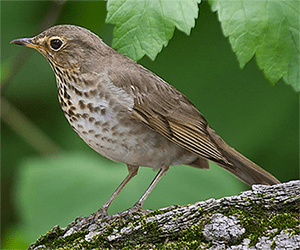
Swainson’s Thrush has the most distinctive face pattern among the Catharus thrushes: a bold, buffy eyering connecting to buffy lores to form “spectacles” against a brown face. The breast spotting is indistinct, and the upperparts are a uniform brown (usually a subdued olive-brown, or reddish-brown in the West). Their songs are flutelike and spiral higher and higher as the song goes on. They lack the Hermit Thrush’s clear introductory note.
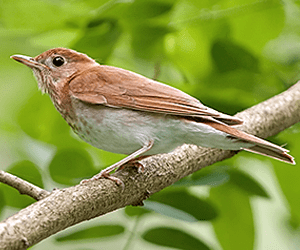
The Veery is warm rusty-red all over, and has the least distinct spotting on the underparts of any of these five thrush species. Its fluting songs tumble progressively downward; they also have a distinctive, short call note that sounds like part of its name: veer.
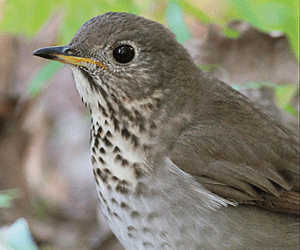
More possibilities: Gray-cheeked Thrush and Bicknell’s Thrushes The two others in our 5-species group, Gray-cheeked and Bicknell’s, aren’t as commonly seen as the previous three. They do occur widely in the East during migration, though (especially Gray-cheeked), so it’s good to be on the lookout. Gray-cheeked Thrushes are somber olive-brown across the upperparts, with a plain grayish-brown face that at best shows only a hint of an eyering. The breast has distinct spots. Their song is jumbled and burry, ending on a falling pitch.
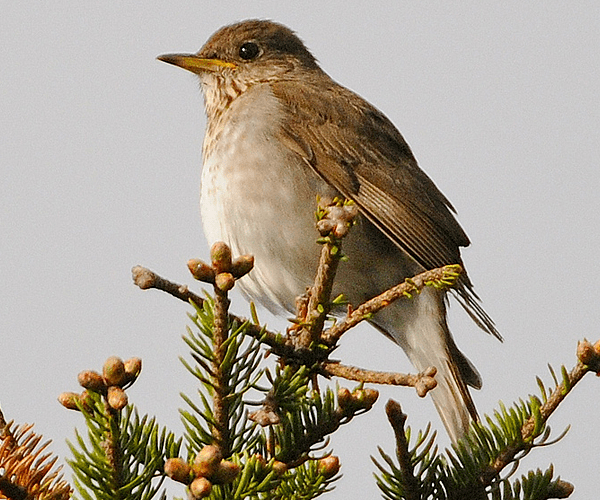
Bicknell’s Thrush was split out as a full species from Gray-cheeked Thrush only in the 1990s. Its plumage is essentially identical, but its song is different and its breeding range (parts of New England and northeastern Canada) and wintering range (Caribbean, particularly Hispaniola) are different.
5. So—which species? Let’s put it all together: the bird in the top image is a thrush with a thin eyering and distinct spots on the breast. It is brown above with a warmer rusty color on the tail. It is a winter resident and early migrant across much of the continent—it’s a Hermit Thrush! Armed with this approach—four keys and a sense of timing—now you can head outside and practice these steps with any thrush you encounter. Good luck!
For more help with bird identification:
- Our free Merlin Bird ID app incorporates timing and location in its suggestions for the most likely birds near you. Try it now on iOS7 devices; coming soon for Android
- Practice the four keys to bird ID on our Building Skills pages
- For more in-depth, interactive training, check out our tutorials and webinars
- Find much more ID and life history information in our All About Birds species guide
(Thanks to Benjamin Van Doren/BirdCast for preparing the map images.)

All About Birds
is a free resource
Available for everyone,
funded by donors like you
American Kestrel by Blair Dudeck / Macaulay Library

